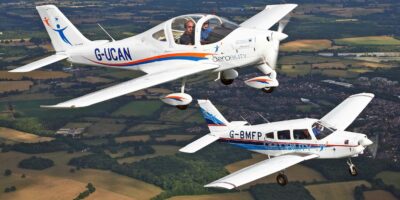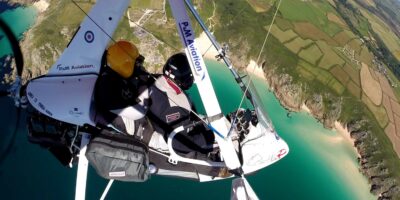Have you ever dreamed of flying for your country? The modern British Armed Forces consists of the Royal Air Force (RAF), Fleet Air Arm (FAA) and Army Air Corps (AAC). The variety of work undertaken by the military means that you could find yourself ferrying supplies to flooded villages in the UK, conducting anti-narcotics patrols in the Caribbean or hunting for submarines in the North Sea.
To succeed as a military pilot you’ll need to invest plenty of time and energy into the various phases of recruitment and selection. However, the reward for success comes with one huge benefit – you won’t need to pay for your training, you’ll actually be paid to train.
The lifestyle of a military aviator is very different from that of a commercial pilot, however the adoption of proven civilian airframes now means that the differences aren’t as vast as you’d think.
With the RAF now operating the Airbus A330 Multi Role Tanker Transport (MRTT) and the Boeing P-8A Poseidon – based on the 737-800 – there are now career paths that can look and feel very similar to civilian pilots. You might still deploy for weeks at a time with your aircraft to far corners of the world.
While the peculiarities of military life might not suit some, the opportunities to travel, forge lasting friendships and see the world can more than make up for it. Most Officer roles will give the opportunity to further your education and obtain degrees or certifications that will help both your military career as well as a transition to a civilian life.
Royal Air Force
www.raf.mod.uk/recruitment/
Many people think of the RAF first when considering a flying career in the military. The youngest of the three main branches of the Armed Forces, the RAF is responsible for strategic and tactical transport, while also defending the skies of the UK 24/7.
Throughout the recruitment process, you will be assessed and streamed, based on your aptitude, toward various flying careers.
These include fast jet flying, where you could be conducting air-to-air or ground attack missions in the Typhoon or new F-35 Lightning. Other options include transport, supporting UK operations worldwide by flying people and equipment to far-flung destinations.
Other fixed-wing opportunities include flying the RAF’s intelligence, surveillance, and reconnaissance (ISR) aircraft, which includes the Beechcraft King Air, Boeing E-3D Sentry, RC-135 Rivet Joint or the future E-7A Wedgetail (based on the 737). The RAF also operates a frontline mixed rotary fleet of Puma, Chinook and Griffin helicopters.
You must enter the system between the age of 17.5 years old and the day of your 26th birthday. The minimum commitment is 12 years service.
You must pass fitness tests, medicals and hold the appropriate number of GCSEs and A-Levels. As an Officer you will begin service life with a 24-week training course at RAF Cranwell in Lincolnshire. You can expect to earn £27,818 during this (Modular) Initial Officer Training (MIOT), rising to £33,436 after training.
Flight Lieutenant Scotty Edmed said, “Showing that you’ve gone above and beyond during your education and training with things like sports or joining the Air Cadets will help you stick out and improve your chances of a successful application.”
Elementary Flying Training is conducted by Ascent Flight Training, responsible for delivering fixed- and rotary-wing training at RAF Cranwell, RAF Valley and RAF Shawbury. Initial training begins on the Grob Tutor and Prefect before you are then directed toward fast-jet, multi-engine or rotary. Fast jet pilots will train on the Texan and Hawk T2, multi-engine pilots on the Phenom 100 and those chosen for rotary will fly the Juno and Jupiter helicopters.
Fleet Air Arm
www.royalnavy.mod.uk/careers
The Royal Navy’s aviation branch is called the Fleet Air Arm and has an illustrious history and a bright future, thanks to the introduction into service of the new F-35 Lightning fighter.
As a pilot in the FAA you could find yourself hunting for submarines in any of the world’s oceans, supporting humanitarian supply missions after natural disasters or covertly dropping Royal Marine Commandos behind lines. It goes without saying that operating aircraft from vessels out at sea is one of aviation’s most challenging environments.
Before applying for a career as a pilot in the Royal Navy you must be aged between 17-34 with a minimum of 96 UCAS points, five CGSEs at grades A-C and be able to pass a swimming test.
Pay and benefits in the FAA include a starting salary of £27,000, rising to £33,000 within two years, additional flying pay, six weeks of paid holiday and free medical and dental care.
An Officer’s commission into the Royal Navy will be a minimum 12-year commitment and before you begin initial training, you will undergo Flying Aptitude Tests at RAF Cranwell, before going to Britannia Royal Naval College in Dartmouth for 30 weeks of military skills, maritime skills and fleet training.
Lt Commander Chris Suckling, a Merlin helicopter instructor said, “Research what you want to do, get online and read up on people’s experiences. Talk to people on social media who can help, many are willing to share their experiences. Then set yourself a step-by-step plan and concentrate on hitting each goal.”
After BRNC there are 15 weeks of training to learn more about the Royal Navy’s aircraft culminating in ‘grading’ tests to determine whether you are suitable for life as a pilot. If you complete this, your next task is 30 weeks of Elementary Flying Training at RAF Barkston Heath. Those streamed to rotary-wing flying will undertake another 30 weeks of flying at RAF Shawbury and 12 months flying your chosen helicopter. Fixed-wing pilots will train at RAF Linton-on-Ouse for 49 weeks, before a further two years of fast jet training.
Army Air Corps
www.army.mod.uk/careers
The Army Air Corps (AAC) is the combat aviation arm of the British Army.
It is unique among British military aviation as it selects not only commissioned (officer) but also non-commissioned officer (soldier) aircrew. Already in-service soldiers can apply to transfer for AAC pilot training or a number of direct entry officer pilots from the Royal Military Academy Sandhurst (RMAS) are commissioned each year.
Selection process…
As part of the selection process candidates undertake 13 hours flying grading selection on a Grob Tutor light aircraft. This can be achieved as a civilian who has accepted a commissioning course at RMAS. Scheduled from later this year, the Army Pilots Course will be rotary-wing only in a new fleet of Airbus H135.
Through basic, advanced and operational training courses students will be taught how to operate a military helicopter safely and tactically. This could be in any weather, at night, low level and cross-country to achieve a set time on a mission.
At the end of training the coveted and well-deserved Army wings are presented. With around 250 hours flying time aircrew will progress onto conversion for their frontline type. This is primarily the new Apache ‘Echo’ attack helicopter or Wildcat reconnaissance helicopter but opportunities also exist to fly Gazelle and Bell 212 in different roles.
As a frontline pilot you will play a key part in military exercises and operations at home and abroad. An Apache pilot may be supporting troops on the ground with Hellfire missiles or 30mm cannon and a Wildcat pilot will use sophisticated cameras and sensors to bring critical information to commanders. Moreover, during the Covid-19 crisis Wildcat were part of the national task force to support the NHS around the country.
On top of the excellent flying opportunities, army pilots are expected to apply their leadership skills to get the best from the diverse people they command.
You’ll earn £27,800 during your year at RMAS and this will rise to £42,800 as a Captain after a further three years.
On top of the pay (with extra remuneration for aircrew) and world-class flying training the army offers much more – such as free medical, dental and gym access.
Additionally there are opportunities for further education with Sandhurst graduates offered an optional MSc in Leadership and Strategic Studies and a pathway to BSc (Hons) in Aviation Systems Management for pilots.








